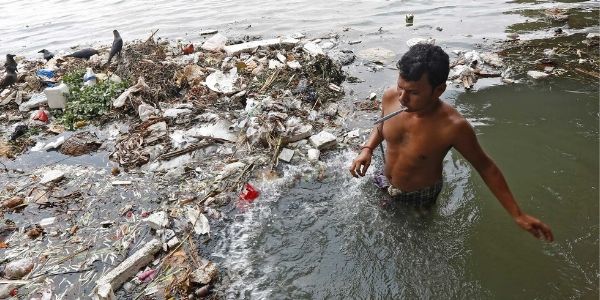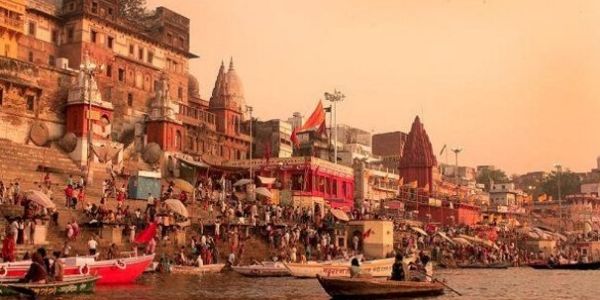We all have heard about the river Ganga which flows south and east from the Himalayas, forming a canyon as it leaves the mountain. In this article, we have added the complete information on the Ganga Action Plan. We have added all details like objectives, a case study of the Ganga action plan project, and various information. It is essential to know as a part of the exam. So, we suggest one note the essential points while reading the below article.
The Ganges
Before understanding the details of the Ganga Action Plan, the Ganges is a transboundary river of Asia that flows through India and Bangladesh. Then, it is called Ganga in Hindi and other Indian Languages, and internationally it is known by its conventional name, the Ganges. The river Ganga rises in the Himalayas into the Bay of Bengal. Further, it drains one-fourth of the territory of India, and its basin supports hundreds of millions of people. Besides, the course of the Ganges flows through the Indian territory. The general direction of the river’s flow is from northwest to southeast. Further, the below table gives you details of the River Ganga.
| Country | India (as Ganga), Bangladesh (as the Padma) |
| Location | Ganges Delta |
| Length | 2,500 km (1,600 mi) |
|---|---|
| Basin size | 1,016,124 km2 (392,328 sq mi) |
| Discharge | |
| Location | Farakka Barrage |
| Average | 16,648 m3/s (587,900 cu ft/s) |
| Minimum | 180 m3/s (6,400 cu ft/s) |
| Maximum | 70,000 m3/s (2,500,000 cu ft/s) |
| Discharge | |
| Location | Ganges Delta, Bay of Bengal |
| Average | 18,691 m3/s (660,100 cu ft/s) |
The volume of the Ganga increases significantly as it receives more tributaries and enters a region of heavier rainfall. Further, from April to June, the melting Himalayan snows feed the river. Then, in the rainy season, from July to September, the rain-bearing monsoons cause floods. Further, click here to know the river’s current state; we all know it is one of the holy rivers. However, the river is highly polluted. So, improve the river this particular project planned.
Ganga Action Plan
The Ganga Action Plan (GAP) started in 1986. Further, the plan is a 100% centrally sponsored scheme, and under this plan, the National River Ganga basin authority was established and declared Ganga as a national river of India.
Background Details
What is the motto behind Ganga Action Plan? It is because of the water pollution problem. The river water has been rising continuously because of industrialization along the river stretches, open defecation, and many other issues. The authority is headed by the prime minister and chief ministers of all the states where Ganga flows. Further, the plan had two phases.
- Phase I – It was launched in 1983, which covers seven states that include Uttarakhand, UP, Bihar, Jharkhand, West Bengal, Delhi and Haryana.
- Further, in the Phase II – It was started in 1993. The national river conservation plan was started under the same program for the 2nd phase. Under this 152 towns located along 27 interstate rivers in 16 states are covered.
Further, various other plants have also been undertaken, like GAP, such as the Yamuna action plan (YAP). Besides, a total of 33 rivers are present under this. Later, the supply of pure water is essential. Else, water-borne diseases like cholera, typhoid, etc., can spread through water. Also, toxic chemicals like mercury, arsenic, and cadmium can cause severe diseases to the human body.
Objectives of Ganga Action Plan
The Ganga Action plan launched in the year 1986 on 14th January. The project’s main aim was to lower pollution and improve water quality in the Ganga river. But, first, let us look into the objectives of the Ganga Action Plan.
- In the first place, installation of sewage treatment facilities for the treatment of the intercepted sewage.
- It was in importance of protect biodiversity, developing an integrated river basin management approach. Further, it is important for to conduct research to know other objectives, and gain experience of implementing similar river clean-up programs in other polluted rivers in India.
- Further, to intercept and divert the sewage draining into the river.
- To provide low-cost sanitization to communities and individuals.
- Development of the riverfront and Afforestation, and creating public awareness
Ganga Action Plan Project Overview
After understanding the objectives and the background details of the Ganga Action Plan, we will look into the project insights below.
- Ganga Action Plan is completely sponsored scheme and with this project river Ganga declared Ganga as a national river of India.
- This project was directed by the Rajiv Gandhi. Further, the authority is headed by the prime minister and chief ministers of all the states in which river Ganga flows.
- Besides, the Ministry of Environment and forests was made in charge of the overall design and implementation of the project.
As we have mentioned above, there were two phases; let us understand each phase below.
Ganga Action Plan, Phase 1
The main aim behind launching the Ganga Action plan is to achieve all the objectives and to clean the river as it signifies purity and spirituality. Further, phase 1 aimed to restore river water quality to the Bathing Class Standard and improve water quality. Additionally, to reduce the river’s pollution and prevent toxic industrial wastes from entering the river. To conduct proper research and understand how to maintain the purity and cleanliness of the river. Besides, to prevent the entry of non-point pollutants into the river. Later, to use Ganga as a resource recovery option to produce Methane for energy generation. Further, the development of new sewage treatment technology.
Phase 1 of the project involved the construction of three new sewage treatment plants with a combined installed capacity of approximately 101,800m³ a day.
Ganga Action Plan, Phase 2
Further, phase 2 aimed at the city of Varanasi, India. Additionally, it involved the construction of a new 140,000m³/d sewage treatment plant (STP). It consisted of laying 34kms of sewers, rehabilitation of existing sewerage systems, and construction of three new pumping stations, namely Phulwaria, Chaukaghat, and Saria. Besides, to improve the water quality in the Ganga River.
The overall investment earmarked for the project is INR4.97 bn, of which 85% will be provided by the central government and the remaining 15% by the state of Uttar Pradesh.
National Mission for Clean Ganga
The river Ganga is one of the world’s most populated river basins, with about 600 million people living in urban and rural areas. Further, the river Ganga contributes around 40% of India’s GDP and major economic and environmental asset. Additionally, the National Mission for Clean Ganga protects and manages River Ganga. The mission became a registered society on August 12, 2011, under the Societies Registration Act, 1860. Further, from 10th December to 15th December India Water Impact Summit 2020 was held virtually. Later, the World Bank has granted an Rs. 3,000 crore 5-year loan to the National Mission for Clean Ganga (NMCG).
Conclusion
In summary, the above article will give you complete information on the case study on Ganga Action Plan Project. Further, understand other details like a case study on the Ganga action plan and objectives of the Ganga action plan. The Ganga Action Plan was executed in two-phase and above; we have explained both phases. The project’s main aim is to clean the river Ganga, and we have added information on the river Ganga. Further, try to make notes while reading the article. Besides, as a part of the UPSC exam study materials, it is essential for the exam. Later, check out all the other essential concepts for the IAS exam. Click Here and get all information.
Further, the IAS exam comes with the longest syllabus, and one needs to cover the entire syllabus to get the best results in the exam. Therefore, this particular topic is also important for the exam, and we have added all the details that will help you with the IAS exam preparations. Get all information related to the IAS exam like syllabus, paper pattern, books, tips, and other details. Click Here.
FAQs
Ganga Action Plan (GAP) Phase-I in the year 1985.
Shri Rajeev Gandhi planned the Ganga Action Plan.
The project’s main aim was to lower pollution and improve the quality of water in the Ganga.
The new name is National River Action Plan (NRAP).
Editor’s Note | Ganga Action Plan
In brief, the article mainly speaks about Ganga Action Plan and a case study on the Ganga action plan. It is one of the essential projects launched for all over development of the river Ganga. Further, get all information like objectives, background details, phases one and two. As a part of the IAS exam, one must understand the important points of the project. However, it is tough to remember everything, so that one can go through the previous year’s question papers, you will understand how questions will be. Besides, it also helps one know the paper pattern and the exam syllabus. Moreover, various platforms provide you with mock test series, and it will help you understand your skills and how you can improve your skills.










